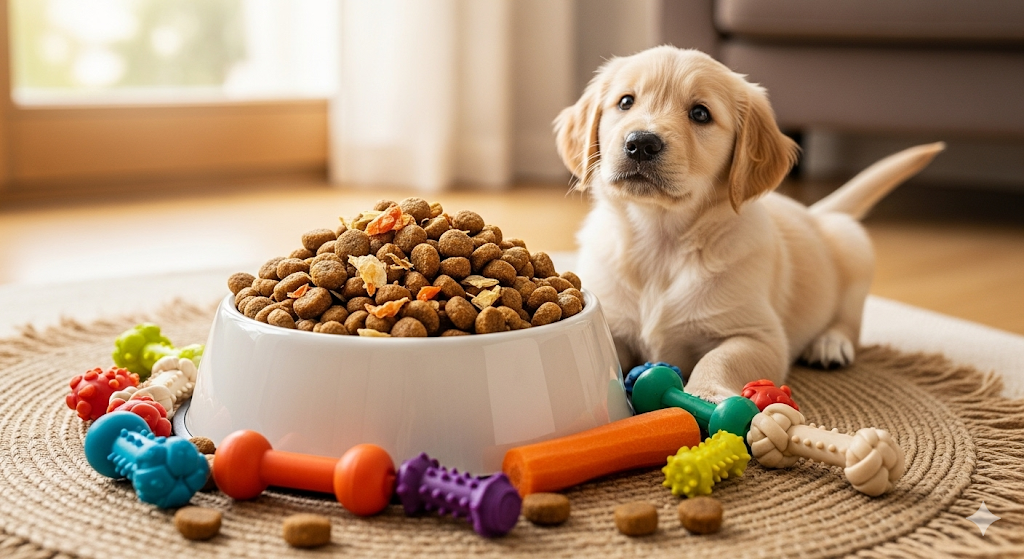
Bringing home a puppy is one of life’s great joys. But with that joy comes responsibility — especially when it comes to nutrition. The first year of a pup’s life sets the foundation for strong bones, healthy organs, a shiny coat, and a resilient immune system. Choosing the right food is essential. Let’s explore what makes a good puppy food, what to look for, feeding schedules, and how to keep your puppy growing strong and healthy.
Why Puppy Nutrition Matters
- Puppies are not just small adult dogs. They have rapid growth, developing organs, bones, immune systems, and brains. Proper nutrition impacts long-term health.
- Nutrient deficiencies or imbalances (especially too much or too little calcium) can lead to skeletal issues, joint problems, or developmental delays.
- Overfeeding or feeding low-quality food may cause excessive weight gain, strain on joints, or obesity-related risks later in life.
What to Look for in a Quality Puppy Food
When selecting food for your puppy, here are the key features and nutrients to check:
| Feature | Why It Matters |
|---|---|
| AAFCO Statement | Ensures the food meets standards for growth and development. Look for a statement like “Complete & Balanced for Growth” or “Growth of Large-Size Dogs”. |
| High-Quality Protein Source | Protein supports muscle, tissue, and organ development. Look for named meats like chicken, lamb, beef, or fish as first ingredients. |
| Healthy Fats & DHA / Omega-3 | Fats are energy-dense; DHA supports brain and eye development. Essential fatty acids help skin, coat, and overall vitality. |
| Balanced Calcium and Phosphorus | Especially important for puppies—too much or too little can harm bone growth. Large-breed puppies are particularly sensitive. |
| Digestible Carbohydrates & Fiber | Helps with gut health and energy. Ingredients like sweet potatoes, oats, and quinoa are well tolerated; moderate fiber aids digestion. |
| Minimal Fillers, Artificial Additives | Avoid artificial colors, flavors, and preservatives. Cleaner ingredients usually mean fewer allergic reactions or digestive upset. |
How to Feed: Frequency & Portion Size
Knowing how much and how often to feed is as important as what you feed.
| Age | Recommended Number of Meals Per Day |
|---|---|
| 6–12 weeks | 4 meals/day — babies need energy frequently. |
| 3–6 months | 3 meals/day — adjusting as they grow bigger. |
| 6–12 months | 2 meals/day — many puppies can switch to twice daily, but large breeds may benefit from 3 meals depending on growth rate and vet advice. |
Also:
- Always use measured portions rather than free-feeding. Monitor body condition instead of focusing only on an empty bowl.
- Treats should be limited to no more than 10% of the puppy’s daily caloric intake.
Special Considerations by Breed Size
Not all puppies grow at the same rate. Breed size influences dietary needs:
- Small Breeds: Faster metabolism and earlier maturity. They need energy-dense food, smaller kibble, and may switch to adult food a bit earlier (around 9 months).
- Large & Giant Breeds: Slower growth span (sometimes up to 18-24 months). Require stricter control over calcium, phosphorus, and calorie intake to avoid fast growth that can stress joints.
Wet, Dry, Raw, or Fresh? Pros & Cons
- Dry kibble: Affordable, convenient, and helps with dental health.
- Wet / canned food: More moisture, good for picky eaters, but usually more expensive and less practical.
- Raw / Fresh / Homemade diets: Can offer high-quality, minimally processed nutrients, but must be carefully balanced and supervised by a vet to avoid deficiencies.
Common Feeding Mistakes to Avoid
- Switching foods too abruptly — always transition slowly over about 7 days.
- Overfeeding or letting your puppy become overweight — obesity early can lead to lifelong health issues.
- Using too many treats or table scraps — they add calories and can unbalance nutrition.
- Feeding adult-dog food too early — misses important nutrients that puppies need.
Sample Puppy Food Options
While brands vary by region, here are types of puppy foods many vets recommend:
- Premium dry kibble with a high protein source
- Balanced wet food or a wet + dry combination
- Natural, fresh meals or raw diet options (if properly formulated)
At PetsDogPuppy, we encourage pet parents to choose foods that meet growth standards, use wholesome ingredients, and are tailored to breed size.
When to Switch to Adult Food
- For small to medium breeds, many dogs are ready at 9-12 months.
- Large and giant breed dogs often need puppy food up to 12-18 months, sometimes longer depending on growth and vet’s advice.
- Monitor their growth, body condition, and consult your vet before making the switch.
Conclusion
Feeding your puppy the right food is one of the best investments you can make in their lifelong health. Prioritize:
- balanced, high-quality ingredients
- proper nutrients like protein, fats, calcium, and DHA
- correct portion sizes and feeding frequency
- breed-appropriate formulas
With the right food and care, your puppy will have the energy, structure, and health to grow into a strong and happy adult dog. At PetsDogPuppy, we are committed to helping you find nutritious, safe foods so your puppy gets the very best start in life.
